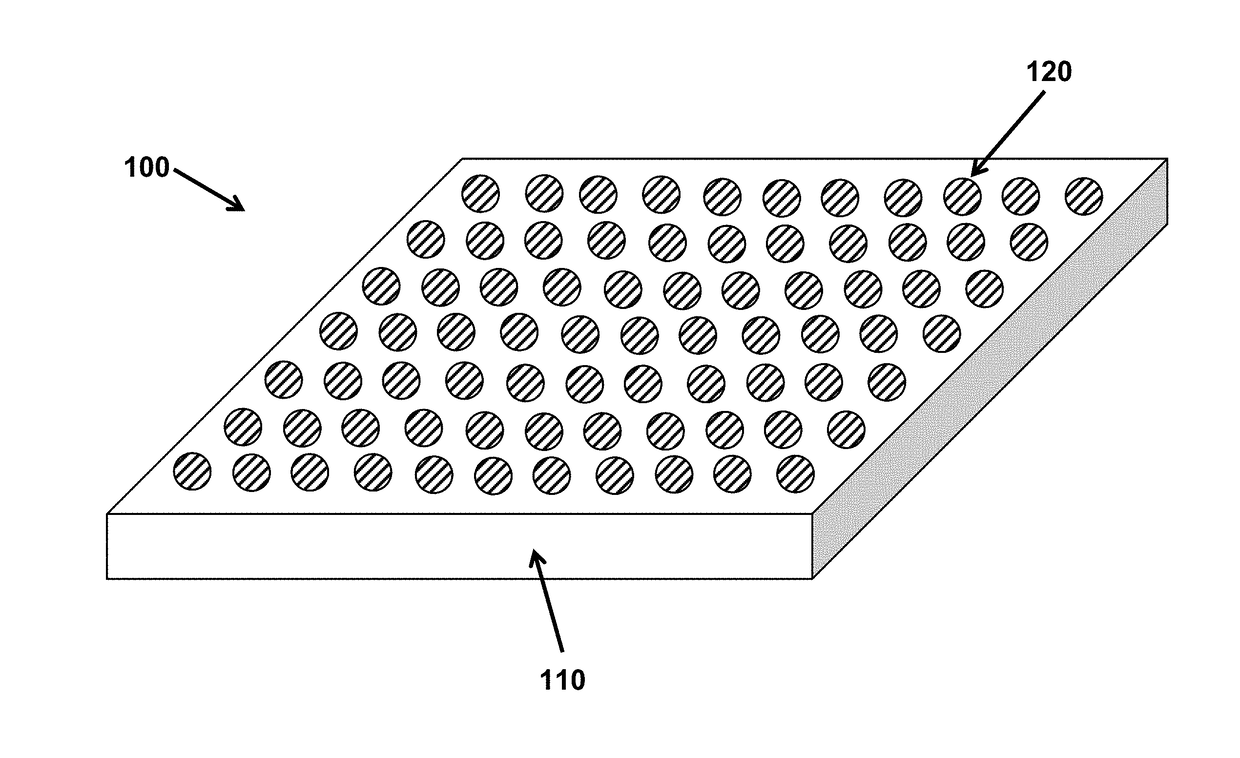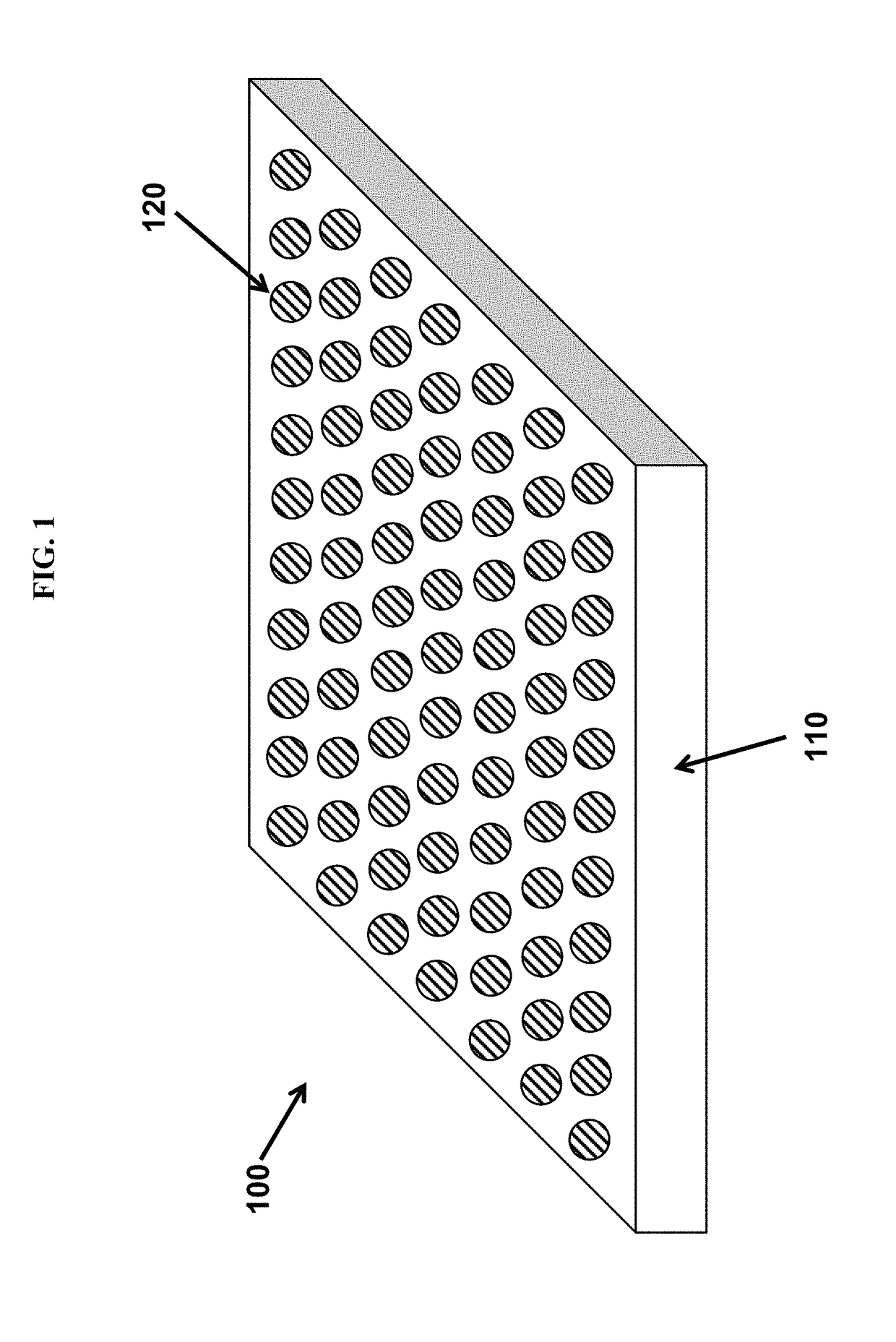Compositions and methods for fabricating durable, low-ice-adhesion coatings
a technology of low-ice adhesion coatings and compositions, applied in the direction of antifouling/underwater paints, biocides, coatings, etc., can solve the problems of no practical protection in airborne icing conditions, removal of existing contamination, and engine-related inlet icing
- Summary
- Abstract
- Description
- Claims
- Application Information
AI Technical Summary
Benefits of technology
Problems solved by technology
Method used
Image
Examples
example 1
dhesion Material
[0253]PEG (1.5 mmoles, 5.1 g) and HMDI (15 mmoles, 3.94 g) are added into a 3-neck flask equipped with a mechanical stirrer. The reaction flask is placed in a 100° C. oil bath. Once PEG is melted and dissolved in the HMDI, 10 μL of DBTDL is added to the mix. The reaction mixture is stirred at 100° C. for 1 hour. Fluorolink D4000 (1.5 mmoles, 6 g) is added and stirring is continued for another 1 hour. The reaction flask is removed from the 100° C. oil bath and allowed to cool down before adding THF (10 mL) and BD (12 mmoles, 1.08 g) dissolved in THF (2 mL). The THF and BD are added to the viscous resin and vortexed to disperse and thin the overall mixture. The sample is sprayed with an HVLP gun using a 1.7 mm nozzle aperture to a thickness of 8.5 mils. The spray coating is allowed to cure under ambient conditions for 16 hours.
[0254]The kinetic delay of freezing is measured by placing 50 μL drops of deionized water on a surface held at −10° C. with a thermoelectric coo...
example 2
dhesion Material
[0256]PEG (1.0 mmoles, 3.4 g) and HMDI (19.3 mmoles, 5.06 g) are added into a 3-neck flask equipped with a mechanical stirrer. The reaction flask is placed in a 100° C. oil bath. Once PEG is melted and dissolved in the HMDI, 10 μL of DBTDL is added to the mix. The reaction mixture is stirred at 100° C. for 1 hour. Fluorolink E10H (2.7 mmoles, 5.27 g) is added and stirring is continued for another 1 hour. The reaction flask is removed from the 100° C. oil bath and allowed to cool down before adding THF (10 mL) and BD (15.4 mmoles, 1.39 g) dissolved in THF (2 mL). The THF and BD are added to the viscous resin and vortexed to disperse and thin the overall mixture. The sample is sprayed with an HVLP gun using a 1.7 mm nozzle aperture to a thickness of 4 mils. The spray coating is allowed to cure under ambient conditions for 16 hours.
[0257]The kinetic delay of freezing is measured by placing 50 μL drops of deionized water on a surface held at −10° C. with a thermoelectric...
example 3
dhesion Material
[0259]PEG (1.5 mmoles, 5.1 g) and HMDI (15 mmoles, 3.94 g) are added into a 3-neck flask equipped with a mechanical stirrer. The reaction flask is placed in a 100° C. oil bath. Once PEG is melted and dissolved in the HMDI, 3 μL of DBTDL is added to the mix. The reaction mixture is stirred at 100° C. for 1 hour. Fluorolink D4000 (1.5 mmoles, 6 g) is added and stirring is continued for another 1 hour. The reaction flask is removed from the 100° C. oil bath and allowed to cool down before adding THF (10 mL) and BD (12 mmoles, 1.08 g) dissolved in THF (2 mL). The THF and BD are added to the viscous resin and vortexed to disperse and thin the overall mixture. The sample is sprayed with an HVLP gun using a 1.7 mm nozzle aperture to a thickness of 4 mils. The spray coating is allowed to cure under ambient conditions for 16 hours.
PUM
| Property | Measurement | Unit |
|---|---|---|
| surface energy | aaaaa | aaaaa |
| thickness | aaaaa | aaaaa |
| effective diameter | aaaaa | aaaaa |
Abstract
Description
Claims
Application Information
 Login to View More
Login to View More - R&D
- Intellectual Property
- Life Sciences
- Materials
- Tech Scout
- Unparalleled Data Quality
- Higher Quality Content
- 60% Fewer Hallucinations
Browse by: Latest US Patents, China's latest patents, Technical Efficacy Thesaurus, Application Domain, Technology Topic, Popular Technical Reports.
© 2025 PatSnap. All rights reserved.Legal|Privacy policy|Modern Slavery Act Transparency Statement|Sitemap|About US| Contact US: help@patsnap.com



